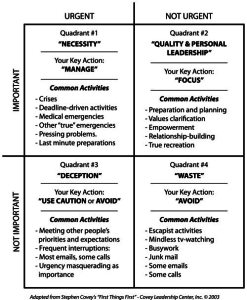
Procrastination is way more fun.
For today’s post, we are featuring a guest author. Makenzie Strottner is a freshman in college, but already has more certifications and qualifications than most professionals. She’s also the newest employee here at Infinite Mind. Makenzie came to me with an idea for an article about procrastination. She told me about her experience in the Franklin Covey Time Management program, and I said, “you’re more than qualified to write this article!” And so, without further delay, I’m turning it over to Makenzie:
Picture This…
It’s Sunday night and you’re about five pages into your reading assignment. You’ve been putting it off all weekend, so now it’s crunch time. You had originally planned to break that 50-page reading assignment into smaller chunks and get it done throughout the weekend, but you were too busy! Friday night you just had to go see that new movie with your friends. Saturday night was no good either, you and your roommate went to that party across campus. Now you’re out of time, overwhelmed, and completely stressed out. You have to finish the reading assignment so you’re prepared for the quiz tomorrow! While contemplating if you really need to pass that quiz in the morning, you look down at your phone and see a notification from Netflix. The latest season of your favorite show is now available! You think to yourself “oh I’ll just watch one episode.” One episode quickly turns into one season, and before you know it, it’s time for class. Your reading assignment is incomplete and you rush to class hoping that by some miracle you pass your quiz.
Has any of you ever put yourself in a situation like this? Chances are if you’re a college student, this has probably happened to you more than you’d like to admit. Procrastination is a plague that sweeps across college campuses everywhere. Avoid becoming further contaminated and learn how to kick that nasty habit of procrastination.
The Time Matrix
The key to kicking procrastination is knowing how to prioritize tasks and effectively manage your time. In order to better manage your time, you first need to understand how you are currently spending your time. The Franklin Covey Time Management System divides time into four quadrants.
Quadrant I- The Quadrant of Crises
This quadrant consists of tasks that are both important and urgent. Tasks that fall into this quadrant are crises, emergencies, and deadline-driven activities (that 50-page reading assignment you need to complete before tomorrow). You should aim to manage these tasks to the best of your ability and, if possible, prevent tasks from falling into Quadrant I in the first place.
Quadrant II- The Quadrant of Quality
This quadrant consists of tasks that are important, but not urgent. Tasks that fall into this quadrant are things you really should get started on, but can put off for a couple of days (studying for your upcoming midterms). Ideally, this is where you should focus most of your time because this is where you will be the most productive. They key is to accomplish all of your Quadrant II tasks, before they become a Quadrant I task.
Quadrant III- The Quadrant of Deception
This quadrant consists of tasks that are not important, but urgent. This is referred to as the “quadrant of deception” because tasks in this quadrant appear important, but really aren’t. Frequent interruptions and most emails/phone calls are examples of Quadrant III tasks. A phone call requires your immediate attention, but most of the time it isn’t super important and ends up wasting valuable time. You should use caution with Quadrant III tasks, and avoid spending too much of your time here.
Quadrant IV- The Quadrant of Waste
This quadrant consists of tasks that are not important and not urgent. Tasks that fall into this category are referred to as “time-wasters.” Binge watching your favorite Netflix series, busy work, and spending hours on social media are perfect examples or Quadrant IV tasks. You should avoid spending time here as much as possible!
Put Yourself to the Test
The first step to overcoming a bad habit is acknowledging it. Test yourself over the next couple of days and see exactly how much time you waste.
- Create a list of every task you complete throughout the day (yes, every single task)
- At the end of the day approximate how much time you spent completing that task
- Identify which time quadrant that task belongs in
- Your list should look something like this:
- Studying for Biology Midterm- 2 hours, Quadrant II
- Social Media- 45 minutes, Quadrant VI
- Math Assignment- 1 hour, Quadrant I
- Repeat this process for 2-3 days
Once you have a completed list, it should be easy to identify patterns and pinpoint which tasks take up most of your time. You should also be able to see which time quadrants most of your tasks fall into. You’ll be surprised how much time you waste in Quadrants III and IV. Have no fear though, the good thing about creating a list is you now know exactly what to do in order to more effectively manage your time.
Create a Plan, and Stick to It!
Now that you’ve acknowledged your procrastination problem and identified your time wasters, you can now create a daily To-Do list for yourself. At the start of each day write down all the things you need or want to accomplish. Prioritize each task by assigning it a numerical value, then work in descending order. Complete your #1 priority before moving on to your #2 priority and so forth. Break larger projects and assignments into smaller, more manageable chunks. Instead of adding “type research paper” to your to-do list, try adding “type page 1 of research paper” to your list. We tend to procrastinate tasks that seem difficult, so having the project appear more manageable will make you less likely to put it off until the last minute. If you can stick to your plan not only will you kick your procrastination habit, you will become a less stressed, more productive student!
Consider adding eyeQ to your To-Do list. The seven-minute, daily training sessions change the way your brain reads and processes information. The program’s brain strengthening techniques improve your mental processing, problem-solving, memory, and recall which can help increase study effectiveness. Taking only seven minutes out of your day to exercise your brain can save you hours of reading and studying, leaving you plenty of time to finish watching that new season of your favorite show on Netflix.












